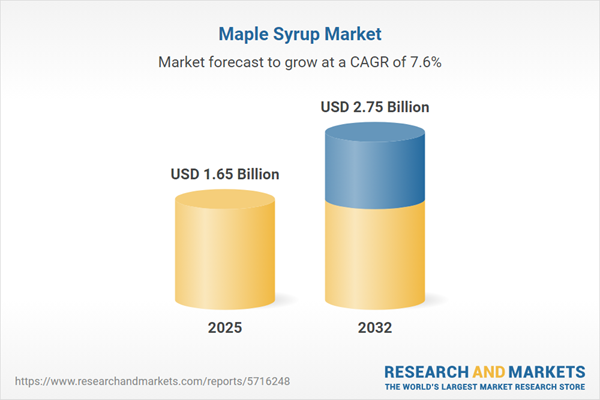Speak directly to the analyst to clarify any post sales queries you may have.
The global maple syrup market is undergoing significant transformation, shaped by customer demand shifts, digital innovation, and sustainability imperatives. Senior executives must access targeted, actionable insights to build adaptive market strategies, manage complex supply chain dynamics, and capture value across diverse regions.
Market Snapshot: Global Maple Syrup Market Overview
The maple syrup market demonstrated robust growth, expanding from USD 1.53 billion in 2024 to USD 1.65 billion in 2025, and is projected to reach USD 2.75 billion by 2032 with a 7.64% compound annual growth rate. Rising consumer and commercial demand is accelerating upgrades of distribution networks and extending supply chain capabilities across new and traditional regions. Producers are investing in technology to drive market stability, access untapped geographies, and deliver increased value for every market stakeholder. These developments are creating opportunities and challenges that require strategic foresight from industry leaders.
Scope & Segmentation: Maple Syrup Market Analysis
- Product Types: Pure maple syrups and flavored options cover culinary, industrial, and foodservice requirements, supporting innovation and adaptation to evolving consumer preferences.
- Nature: Conventional and organic syrup offerings reinforce transparency in sourcing, aligning with organizational sustainability mandates and improving efficiency across procurement channels.
- Grades: Amber Rich, Dark Robust, Golden Delicate, and Very Dark Strong enable companies to match diverse taste profiles and culinary uses, strengthening differentiation in domestic and international markets.
- Distribution Channels: Supermarkets, hypermarkets, convenience stores, e-commerce platforms, foodservice, and specialty outlets ensure comprehensive coverage for established and growth markets.
- Applications: Maple syrup serves as a key ingredient in bakery, beverages, toppings, and confectionery sectors, facilitating partnership opportunities and value creation along the B2B supply chain.
- Packaging Formats: Glass bottles (100ml–1L), plastic containers (up to 2L), and flexible pouches provide solutions for branding, supply chain optimization, and diverse end-user requirements.
- Geographies: Coverage includes North America, Latin America, Europe, Middle East, Africa, and Asia-Pacific, with strategic adaptation required to align with varied regulations and consumer habits. Countries including the United States, Canada, Brazil, China, India, and Australia underscore the market’s regulatory diversity and unique commercial challenges.
- Leading Companies: Major players such as Coombs Family Farms LLC, The J.M. Smucker Company, Maple Grove Farms of Vermont LLC, D.F. Nickerson & Company LLC, TreeHouse Foods Inc., Hain Celestial Group Inc., Northland Organic Foods Corporation, Crosby Molasses Company LLC, Woods & Waters Marketing LLC, and Clarks Maple Syrup Company Inc. are advancing technology integration and inter-industry partnerships to strengthen their positions and respond to emerging sector trends.
Key Takeaways for Senior Decision-Makers
- Digital monitoring tools and advanced traceability systems are boosting operational efficiency, assuring regulatory compliance across large-scale and multinational maple syrup operations.
- Expanding interest in premium, organic, and specialty products is reshaping R&D priorities and supporting authentic branding initiatives that target health-driven consumer segments.
- Regionally tailored strategies are vital: North America remains central for both supply and demand dynamics, Europe intensifies sustainable sourcing commitments, and Asia-Pacific accelerates technological adoption to grow its market profile.
- Collaborations between foodservice operators and health-oriented brands enhance visibility and unlock new paths for sectoral expansion and cross-category growth.
- Digital innovation and e-commerce channels increase agility, allowing companies to adapt swiftly to evolving packaging trends and product format requirements.
Tariff Impact: Navigating Market Access and Trade Structures
Forthcoming changes to United States tariff regulations in 2025 are prompting sector participants to realign sourcing and compliance strategies. Ongoing adaptation is helping organizations effectively address regulatory demands, secure market access, and sustain cost-efficient trade practices as the global environment shifts.
Methodology & Data Sources
This report draws from in-depth interviews with producers, supply chain experts, and senior executives in the food sector. The analysis is further supported by comprehensive regulatory assessments and academic studies. This foundation ensures guidance is both evidence-based and highly relevant for today’s maple syrup market complexities.
Why This Report Matters for Maple Syrup Industry Leaders
- Delivers practical direction for advancing corporate sustainability agendas and embedding resilience against ongoing market change.
- Enables agile supply chain and commercial planning as consumer expectations and regulatory pressures evolve.
- Equips senior executives with timely information to proactively manage regulatory developments and shifting consumer behaviors.
Conclusion
This report empowers leaders to anticipate market changes, implement impactful strategies, and ensure competitive positioning throughout the evolving maple syrup value chain.
Additional Product Information:
- Purchase of this report includes 1 year online access with quarterly updates.
- This report can be updated on request. Please contact our Customer Experience team using the Ask a Question widget on our website.
Table of Contents
3. Executive Summary
4. Market Overview
7. Cumulative Impact of Artificial Intelligence 2025
Companies Mentioned
The companies profiled in this Maple Syrup market report include:- Coombs Family Farms LLC
- The J.M. Smucker Company
- Maple Grove Farms of Vermont, LLC
- D.F. Nickerson & Company LLC
- TreeHouse Foods, Inc.
- Hain Celestial Group, Inc.
- Northland Organic Foods Corporation
- Crosby Molasses Company, LLC
- Woods & Waters Marketing LLC
- Clarks Maple Syrup Company, Inc.
Table Information
| Report Attribute | Details |
|---|---|
| No. of Pages | 197 |
| Published | November 2025 |
| Forecast Period | 2025 - 2032 |
| Estimated Market Value ( USD | $ 1.65 Billion |
| Forecasted Market Value ( USD | $ 2.75 Billion |
| Compound Annual Growth Rate | 7.6% |
| Regions Covered | Global |
| No. of Companies Mentioned | 11 |









